Related Research Articles
Contemporary groups, collectively termed Hindu reform movements, reform Hinduism, Neo-Hinduism, or Hindu revivalism, strive to introduce regeneration and reform to Hinduism, both in a religious or spiritual and in a societal sense. The movements started appearing during the Bengali Renaissance.

Hinduism in Southeast Asia had a profound impact on the region's cultural development and its history. As the Indic scripts were introduced from India, people of Southeast Asia entered the historical period by producing their earliest inscriptions around the 1st to 5th century CE. Today, Hindus in Southeast Asia are mainly Overseas Indians and Balinese. There are also Javanese and Cham minority in Cambodia and southern Vietnam who practices Hinduism.
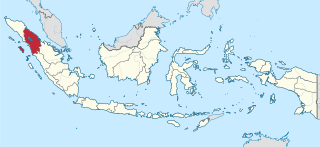
North Sumatra is a province of Indonesia located on the northern part of the island of Sumatra. Its capital and largest city is Medan. North Sumatra is Indonesia's fourth most populous province after West Java, East Java and Central Java. It covers an area of 72,981 km2. According to the 2020 census, the province's population in that year was 14,799,361. The mid-2021 official estimate is 14,936,148.

Batak is a collective term used to identify a number of closely related Austronesian ethnic groups predominantly found in North Sumatra, Indonesia, who speak Batak languages. The term is used to include the Karo, Pakpak, Simalungun, Toba, Angkola, and Mandailing which are related groups with distinct languages and traditional customs (adat).

Hinduism in Indonesia, as of the 2018 census, is practised by about 1.74% of the total population, and almost 87% of the population in Bali. Hinduism is one of the six official religions of Indonesia. Hinduism came to Indonesia in the 1st-century through traders, sailors, scholars and priests. A syncretic fusion of pre-existing Javanese folk religion, culture and Hindu ideas, that from the 6th-century also synthesized Buddhist ideas as well, evolved as the Indonesian version of Hinduism. These ideas continued to develop during the Srivijaya and Majapahit empires. About 1400 CE, these kingdoms were introduced to Islam from coast-based Muslim traders, and thereafter Hinduism mostly vanished from many of the islands of Indonesia.
Yasir Qadhi, is an American preacher, theologian, and imam. Since 2001, he has served as Dean of Academic Affairs at the Al-Maghrib Institute, an international Islamic educational institution with a center in Houston, Texas. He also taught in the Religious Studies department at Rhodes College in Memphis, Tennessee. He is currently the resident scholar of the East Plano Islamic Center in Plano, Texas.

The Huria Kristen Batak Protestan (HKBP), which translates in English as Batak Christian Protestant Church, is a Protestant Christian denomination church and the oriented towards Lutherans among the Batak people of traditionally, generally the Toba Batak in Indonesia. With a baptized membership of 4,500,000, it is one of the largest Protestant churches in Indonesia and Southeast Asia. Its present leader is Ephorus (Bishop) Robinson Butarbutar.

The Karo, or Karonese, are a people of the Tanah Karo and part one of Batak people sub-ethnic group from North Sumatera, Indonesia. The Karo lands consist of Karo Regency, plus neighboring areas in East Aceh Regency, Langkat Regency, Dairi Regency, Simalungun Regency and Deli Serdang Regency. In addition, the cities of Binjai and Medan, both bordered by Deli Serdang Regency, contain significant Karo populations, particularly in the Padang Bulan area of Medan. The town of Sibolangit, Deli Serdang Regency in the foothills on the road from Medan to Berastagi is also a significant Karo town.
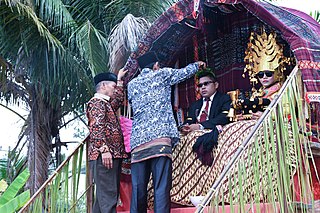
The Mandailing is a traditional one of sub-ethnic cultural group of Batak people from North Sumatera in Indonesia. They are found mainly in the northern section of the island of Sumatra in Indonesia. They came under the influence of the Kaum Padri who ruled the Minangkabau of Tanah Datar. As a result, the Mandailing were influenced by Muslim culture and converted to Islam. There are also a group of Mandailing in Malaysia, especially in the states of Selangor and Perak. They are closely related to the Angkola.
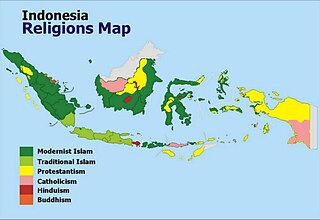
Several different religions are practised in Indonesia and in practice the country is a secular state. Indonesia is officially a presidential republic and a unitary state with a delicate compromise made between the ideas of a secularism model and an Islamic state. Indonesia has the world's largest Muslim population and the first principle of Indonesia's philosophical foundation, Pancasila, requires its citizens to "believe in the almighty God". Consequently, atheists in Indonesia experience official discrimination in the context of registration of births and marriages and the issuance of identity cards. In addition, the Aceh province officially enforces Sharia law and is notorious for its discriminatory practices towards religious and sexual minorities. There are also pro-Sharia and fundamentalist movements in several parts of the country with overwhelming Muslim majorities.
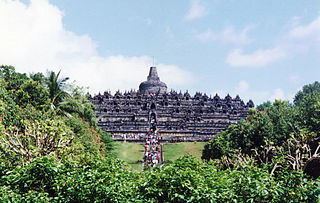
Aliran Kepercayaan is an official cover term for various, partly syncretic forms of mysticism of religion in Indonesia. It includes kebatinan, kejiwaan, and kerohanian. In the Indonesian language, it is also used for local religions and beliefs, even new religious movements, in other parts of the world.

Christianity is Indonesia's second-largest religion, after Islam. Indonesia also has the second-largest Christian population in Southeast Asia after the Philippines, the largest Protestant population in Southeast Asia, and the fourth-largest Christian population in Asia after the Philippines, China and India. Indonesia's 28.6 million Christians constituted 10.72% of the country's population in 2018, with 7.60% Protestant (20.25 million) and 3.12% Catholic (8.33 million). Some provinces in Indonesia are majority Christian.

Christianity in Asia has its roots in the very inception of Christianity, which originated from the life and teachings of Jesus in 1st-century Roman Judea. Christianity then spread through the missionary work of his apostles, first in the Levant and taking roots in the major cities such as Jerusalem and Antioch. According to tradition, further eastward expansion occurred via the preaching of Thomas the Apostle, who established Christianity in the Parthian Empire (Iran) and India. The very First Ecumenical Council was held in the city of Nicaea in Asia Minor (325). The first nations to adopt Christianity as a state religion were Armenia in 301 and Georgia in 327. By the 4th century, Christianity became the dominant religion in all Asian provinces of the Eastern Roman Empire.

The Simalungun people are an ethnic group in North Sumatra, considered one of the Batak peoples. Simalungun people live mostly in Simalungun Regency and the surrounding areas, including the city of Pematang Siantar, an autonomous city, but previously part of Simalungun Regency.

Toba people also referred to as Batak Toba people are the largest group of the Batak people of North Sumatra, Indonesia. The common phrase of ‘Batak’ usually refers to the Batak Toba people. This mistake caused by the Toba people being the largest sub-group of the Batak ethnic and their differing social habit to self-identify as merely Batak instead of ‘Toba’ or ‘Batak Toba’, contrary to the habit of the Karo, Mandailing, Simalungun, Pakpak communities who commonly self-identified with their respective sub-groups.
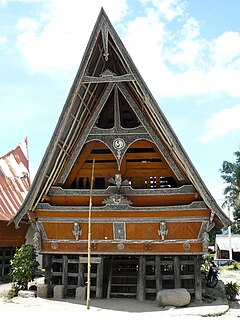
Batak architecture refers to the related architectural traditions and designs of the various Batak peoples of North Sumatra, Indonesia. There are six groups of Batak who speak separate but related languages: the Angkola, the Mandailing to the south, the Toba, to the north the Pakpak/Dairi, the Simalungun, and the Karo. While the groups are now Muslim or Christian, elements of the ancient Batak religion remain, particularly amongst the Karo.

Batak cuisine is the cuisine and cooking traditions of Batak ethnic groups, predominantly found in Northern Sumatra region, Indonesia. Batak cuisine is part of Indonesian cuisine, and compared to other Sumatran cuisine traditions, it is more indigenously preserved. One characteristic of Batak cuisine is its preference to andaliman as the main spice. That is why andaliman in Indonesia sometimes dubbed as "Batak pepper".
Religious syncretism exhibits the blending of two or more religious belief systems into a new system, or the incorporation of beliefs from unrelated traditions into a religious tradition. It is contrasted by the idea of multiple religious belonging and polytheism, respectively.
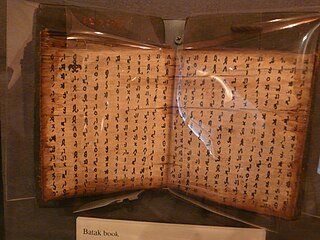
Batak mythology is the original belief that was once adopted by the Batak people of North Sumatra, Indonesia, namely before the arrival of Protestant, Catholic, or Islamic religions. There are various tarombo versions written on pustaha which historians study, but generally refer to the figures below.
References
- 1 2 3 "Archived copy". Archived from the original on 2010-10-18. Retrieved 2010-10-09.
{{cite web}}: CS1 maint: archived copy as title (link) - ↑ Napitupulu, Sahala (2008). "BATAK BUKAN BAKAT: Parmalim Antara Agama Dan Budaya Batak".